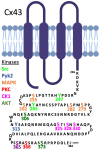Recent advances in connexin gap junction biology
- PMID: 35693635
- PMCID: PMC9171797
- DOI: 10.12703/r/11-14
Recent advances in connexin gap junction biology
Abstract
Connexins are assembled into dodecamer intercellular channels, a collection of which is termed a gap junction, and their canonical function allowing direct exchange of ions and metabolites has been unequivocally established. When initially assembled into undocked cell surface connexin hemichannels, healthy cells may also engage in cell signaling via a regulated small-molecule release. Recent advances in the field have led to an expanded view of the functional roles of intercellular channels and hemichannels in both physiology and pathology. As more of the 21-member human connexin family is intensely interrogated, mounting evidence points to the biological uniqueness of each member, and no longer can we confidently refer to all connexins engaging in the same cellular processes. Innovations in high-resolution cryo-electron microscopy have revealed important insights into the structure of functionally important domains of both hemichannels and channels. These and other studies have established a foundation of knowledge that should allow inhibitory smart drug design for situations where enhanced intercellular or hemichannel activity is at the root of a connexin-linked disease. Assessment of the connexin interactome, which varies widely for each connexin subtype, continues to provide regulatory insights into the assembly and function of connexins that exhibit a short half-life. As the most intensely studied, Cx43 is found in about 50% of all human cell types and is extensively regulated by multiple inhibitory and enhancing phosphorylation events that have direct implications on tissue function and outcomes of disease, including cancer. Here, we briefly discuss these advances and give our thoughts on where the field is headed.
Keywords: channel; connexin; gap junctions; hemichannel.
Copyright: © 2022 Lampe PD et al.
Conflict of interest statement
PDL notes that he is an unpaid member of the Scientific Advisory Board of FirstString Research LLC but states that this service has not influenced this presentation. DWL declares that he has no competing interests.No competing interests were disclosed.No competing interests were disclosed.No competing interests were disclosed.
Figures


Similar articles
-
Emerging issues of connexin channels: biophysics fills the gap.Q Rev Biophys. 2001 Aug;34(3):325-472. doi: 10.1017/s0033583501003705. Q Rev Biophys. 2001. PMID: 11838236 Review.
-
Regulation of gap junction channels and hemichannels by phosphorylation and redox changes: a revision.BMC Cell Biol. 2016 May 24;17 Suppl 1(Suppl 1):11. doi: 10.1186/s12860-016-0099-3. BMC Cell Biol. 2016. PMID: 27229925 Free PMC article. Review.
-
Diversity in connexin biology.J Biol Chem. 2023 Nov;299(11):105263. doi: 10.1016/j.jbc.2023.105263. Epub 2023 Sep 20. J Biol Chem. 2023. PMID: 37734551 Free PMC article. Review.
-
Antibodies targeting extracellular domain of connexins for studies of hemichannels.Neuropharmacology. 2013 Dec;75:525-32. doi: 10.1016/j.neuropharm.2013.02.021. Epub 2013 Mar 13. Neuropharmacology. 2013. PMID: 23499293 Free PMC article. Review.
-
Gating of Connexin Channels by transjunctional-voltage: Conformations and models of open and closed states.Biochim Biophys Acta Biomembr. 2018 Jan;1860(1):22-39. doi: 10.1016/j.bbamem.2017.04.028. Epub 2017 May 2. Biochim Biophys Acta Biomembr. 2018. PMID: 28476631 Free PMC article. Review.
Cited by
-
Perspective and Therapeutic Potential of the Noncoding RNA-Connexin Axis.Int J Mol Sci. 2024 Jun 2;25(11):6146. doi: 10.3390/ijms25116146. Int J Mol Sci. 2024. PMID: 38892334 Free PMC article. Review.
-
Differential substrate specificity of ERK, JNK, and p38 MAP kinases toward connexin 43.J Biol Chem. 2025 Mar;301(3):108178. doi: 10.1016/j.jbc.2025.108178. Epub 2025 Jan 10. J Biol Chem. 2025. PMID: 39798878 Free PMC article.
-
Protector Role of Cx30.2 in Pancreatic β-Cell against Glucotoxicity-Induced Apoptosis.Biology (Basel). 2024 Jun 25;13(7):468. doi: 10.3390/biology13070468. Biology (Basel). 2024. PMID: 39056663 Free PMC article.
-
The genetic and molecular basis of a connexin-linked skin disease.Biochem J. 2024 Nov 20;481(22):1639-1655. doi: 10.1042/BCJ20240374. Biochem J. 2024. PMID: 39513663 Free PMC article. Review.
-
Connexin Gap Junction Channels and Hemichannels: Insights from High-Resolution Structures.Biology (Basel). 2024 Apr 26;13(5):298. doi: 10.3390/biology13050298. Biology (Basel). 2024. PMID: 38785780 Free PMC article. Review.
References
Publication types
LinkOut - more resources
Full Text Sources
Research Materials
Miscellaneous
